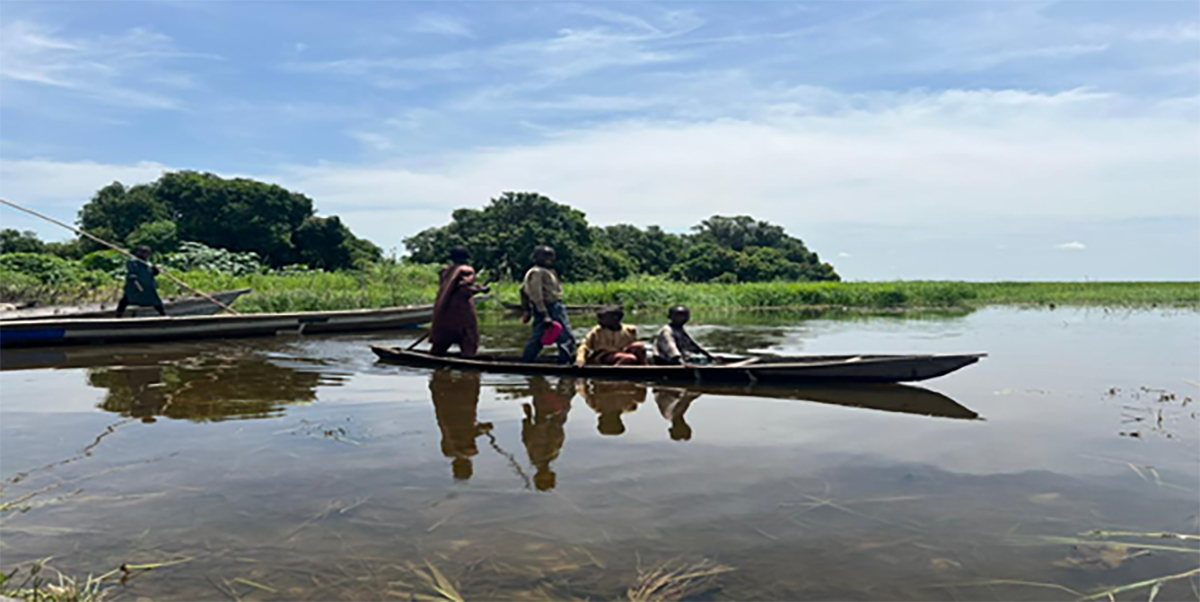

HEALING THE HEART OF THE SAHEL ACReSAL AND THE NGURU WETLAND RESTORATION INITIATIVE
The Nguru wetlands deep in the northwest of Yobe state in Nigeria are a vital segment of the larger Hadejia-Nguru wetlands in the southern edge of the Sahel Savanna. One of the few freshwater ecosystems in northern Nigeria, the wetland is known internationally as the first Ramsar site in Nigeria.
Once spanning an impressive 3000 km² and supporting an astonishing array over 250 species of flowering plants, 136 types of aquatic flora and fauna, 13 species of fish, and 378 species of birds, the Nguru wetlands were a true natural wonder. Tourists and researchers came to explore the park and its wildlife, including the migratory birds from Europe. The wetlands were also a major source of fish, it contributing approximately 6% of Nigeria’s inland fish catches, with a market value of nearly US $300,000 per annum,[1] and supporting over 1.5 million people.
The invasion of Typha grass since the 1970s devastated this delicate environment, overtaking hectares of fishing zones, agricultural lands, grazing regions, ponds, canals, and channels, and causing flooding, sedimentation, siltation, and pollution downstream. The once-thriving recreational boating, swimming, and diving ceased, and mosquito-borne diseases like malaria, cholera, bilharzias, and dysentery increased. The drying up of the water led to the construction of illegal dams and increased deforestation and diversion of the water ways, as people struggled for livelihood – further contributing to the shrinkage and desiccation of the wetlands. Climatic changes and habitat loss reduced soil quality, further affecting people’s livelihoods.
‘The wetland used to experience both flooding and drought in different areas, particularly in the downstream areas of the Nguru Community. Why was this happening? The water channel that brings water from the upstream Nguru-Hadeja Axis was clogged by the invasive Typha grass. This invasion caused siltation along the water channels, leading to blockages that hindered the free flow of water from upstream to downstream’. As a result, some farm areas experienced severe flooding, and grazing lands were also affected. In some areas, fish catch decreased, and farmers avoided farming’ Noted Harry Hamson JR, Project Officer of the NCF/Hadeja-Nguru WETLAND conservation Project, Nguru Yobe Project.
The devastating effects got steadily worse. Farmers who used to collect more than 20 bags of rice from a hectare, now harvested just 5 bags. More than 400 farms of between 2 and 10 hectares in size along the water course were left uncultivated between 2019 and 2024. Many farmers gave up farming. Fishermen migrated to neighbouring states or countries to survive – or found a new profession.
‘This area used to be called Bulaburin (Yan Kifi) meaning the center of fishing activity, because this area had abundant water’, recalls Zanna Maidala Abdu Gazali, the District Head of Ngilewa in the Nguru Local Government Area (LGA) in Yobe State, ‘but, unfortunately, about 11 years ago we couldn’t see water here due to blockage of channels by Typha grass.’
‘I’ve been fishing for 20 years’, said Haruna Mohammed, a fisherman, ‘and we haven’t seen water in Bulaburin Yan Kifi for about 11 years. We faced many challenges … migrated to neighbouring villages for jobs, and some of us, including myself, switched businesses because, without water, there’s no fishing. It was hard to make ends meet. Paying school fees for my 11 children was difficult. Imagine, a fisherman who once earned 10 – 15,000 Naira (~USD 6-9) daily struggled to get N2,000 (~USD 1).’
‘In Nguru, over 20,000 fishermen and two-thirds of the population rely on farming and fishing for their livelihood’, said Adamu Isah BBC, also known as Baba Alhaji, ‘Our people were forced to travel to Chad, Cameroon, and Libya in search of food. To farm, we had to venture into another local government, Bede, incurring significant transportation and labor costs, leading to poverty.”
As the greenery dried up, clashes arose between farmers and herders over the remaining grass. The lack of food led to widespread livestock deaths. Baby animals also fell ill or suffered malnutrition due to inadequate milk production. The cost of fish skyrocketed, becoming unaffordable for ordinary people. Some farmers could not afford to pay school fees and their children had to drop out of schools. Fishermen divorced their wives, as dwindling incomes could no longer support families. Worsening poverty and food scarcity also fueled drug abuse, especially among those unable to migrate.
[1] Birdlife International (2015)
AReSAL
Following several unsuccessful efforts by individual groups, organizations and governments to clear the typha grass through manual methods, the World Bank supported Agro-Climatic Resilience in Semi-Arid Landscapes (ACReSAL) project of the Government of Nigeria began an initiative in 2023.

Heeding suggestions from local stakeholders to find a lasting solution to their problem, the Yobe State Project Management Unit (SPMU) of ACReSAL planned a comprehensive intervention including dredging and clearing blocked channels, restoring degraded areas, large-scale de-silting (including engineering and bioremediation), as well as erosion, flood and Typha weed control, to restore and conserve the wetland ecosystems to better sustain flora, fauna and livelihoods. The intervention plans to restore about 5000 hectares (ha) benefiting over 1 million persons living in a corridor spread across 8 LGAs.[1]
The intervention began with the SPMU procuring an amphibious weed excavator (‘Swamp Buggy’), and starting work on 30 May 2024.
The impact
Even though only 385 of the targeted 5,000 ha since been cleared, the impacts are already visible and tangible: Fishermen have returned to their boats, farmers have gone back to their farmlands, migrants are making their way back to Nguru to return to their previous jobs; downstream farmers can now irrigate their land; fish catch and harvests have increased, improving incomes and related livelihoods.

Haruna Mohammed, a fisherman who saw his income plummet, now earns more – 15 -20,000 (~USD 9-12) per day – and also says: ‘The fish in my basket are more diverse now, unlike before when we only had tilapia.’
Baba Alhaji feels the benefits are higher: fishermen now earn even more: 20 – 30,000 Naira (~USD 12-18) daily, allowing them to buy food, clothing, and medicine. Personally, he has seen output from his own farms go up from the 85 bags of rice he struggled to grow, and the 10 bags he got to keep – after paying more than 10 million Naira on petrol to pump water to his farms. Already, from just one farm, he has harvested 128 bags of rice.
Young Yahaya Abdullahi, who spent 1.5 million Naira in 2023 but almost lost his capital due to a lack of water, has already earned 2.5 million Naira from just 1 of 3 farms, after expanding his cultivation from 2 to 4 hectares because he now has water to irrigate.
[1] The communities covered by the initiative include Bombori, Dere, Dogon Kuka, Dumsai, Garin Bukar, Isari, Kachallari, Kakuri, Maja-Kura, Nagamma, Ngarbi, Ngurodi Wachakal, and Wuga.
Khadija Ahmad Liman also expects huge returns: After seeing wheat yields fall from 100-150 bags to 40-70 bags over the last 11 years due to a lack of water, she anticipates at least 300 bags in 2024.
The Chairman of the Nguru Rice Farmers Association confirms that his data shows that the restoration has already benefited nearly 60,000 farmers, 15,000 herders and 5,000 fishermen directly, with more than 500,000 indirect beneficiaries.
Also, as the waterways have been cleared, traders from neighbouring communities in Jigawa state have begun coming to Nguru.
And the number and diversity of the bird population are increasing including migratory birds from Europe, once unable to land or stay during winter because the water was completely covered by grass.
With channels excavated, water no longer accumulates in farmlands and grazing areas, allowing farmers to cultivate and grazers to utilize the dry areas for their cattle. Not only have the grazing Fulanis communities living in the 8 LGAs reclaimed their restored grazing lands, but nomadic people from neighboring countries like Niger and Chad have also begun to return to graze their cattle. A community leader recalled seeing, during earlier dry seasons, no less than 65-70 cattle herds, each with 20+ herders, totaling a group of 1300 – 1500 including wives and children. With news spreading of better grazing in the Nguru wetlands, herders are likely to return in larger numbers
Yet, there has not been a single conflict between herders and farmers since the intervention. If this newfound peace between farmers and herders continues, despite increasing numbers on both sides, it would perhaps be the most significant impact of the intervention.
Next steps
The full scope of the planned intervention will take at least another 12 months to be completed, and the impacts will have to be maintained, and benefits sustained.
Also, although the middle and lower catchments of the Nguru wetlands are in Yobe state, its upper catchment is in neighbouring Jigawa State – which has a similar challenge and intends to replicate the same intervention.


